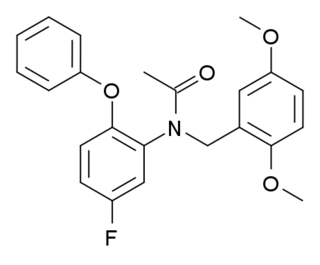Related Research Articles
The following outline is provided as an overview of and topical guide to neuroscience:

Rolipram is a selective phosphodiesterase-4 inhibitor discovered and developed by Schering AG as a potential antidepressant drug in the early 1990s. It served as a prototype molecule for several companies' drug discovery and development efforts. Rolipram was discontinued after clinical trials showed that its therapeutic window was too narrow; it could not be dosed at high enough levels to be effective without causing significant gastrointestinal side effects.
Sir Menelaos (Mene) Nicolas Pangalos is a British neuroscientist of Greek descent.

Xanomeline is a small molecule muscarinic acetylcholine receptor agonist that was first synthesized in a collaboration between Eli Lilly and Novo Nordisk as an investigational therapeutic being studied for the treatment of central nervous system disorders.

DAA-1106 is a drug which acts as a potent and selective agonist at the peripheral benzodiazepine receptor, also known as the mitochondrial 18 kDa translocator protein or TSPO, but with no affinity at the GABAA receptor. It has anxiolytic effects in animal studies. DAA-1106 has a sub-nanomolar binding affinity (Ki) of 0.28 nM, and has been used extensively in its 3H or 11C radiolabelled form to map TSPO in the body and brain, which has proved especially helpful in monitoring the progress of neurodegenerative diseases such as Alzheimer's disease.

Brain positron emission tomography is a form of positron emission tomography (PET) that is used to measure brain metabolism and the distribution of exogenous radiolabeled chemical agents throughout the brain. PET measures emissions from radioactively labeled metabolically active chemicals that have been injected into the bloodstream. The emission data from brain PET are computer-processed to produce multi-dimensional images of the distribution of the chemicals throughout the brain.

DPA-714 or N,N-diethyl-2-[4-(2-fluoroethoxy)phenyl]-5,7-dimethylpyrazolo[1,5-a]pyrimidine-3-acetamide is a selective ligand for the translocator protein (TSPO) currently under evaluation for several clinical applications. For this reason, a practical, multigram synthetic route for its preparation has been described.

Neurolixis is a biopharmaceutical company focused on novel drugs for the treatment of human central nervous system diseases.

25CN-NBOMe is a derivative of the phenethylamine 2C-CN. It acts in a similar manner to related compounds such as 25I-NBOMe, which are potent agonists at the 5HT2A receptor.

25P-NBOMe is a derivative of the phenethylamine 2C-P. It acts in a similar manner to related compounds such as 25I-NBOMe, which are potent agonists at the 5-HT2A receptor. 25P-NBOMe has been sold as a drug and produces similar effects in humans to related compounds such as 25I-NBOMe and 25C-NBOMe.

Jacob M. Hooker is an American chemist and expert in molecular imaging, particularly in the development and application of simultaneous MRI and PET. He has contributed major advances on the entire spectrum of research from fundamental chemistry methodology with radioisotopes to human neuroimaging.

25B-NBF is a derivative of the phenethylamine hallucinogen 2C-B, which acts as a highly potent partial agonist for the human 5-HT2A receptor.
John Albert Katzenellenbogen is an American Professor of Chemistry at the University of Illinois at Urbana-Champaign. He studies the development of novel agents for the treatment of hormone-responsive and non-responsive breast and prostate cancers and the design of estrogens and antiestrogens that have a favorable balance of beneficial versus detrimental effects.
Sarah E. O'Connor is an American molecular biologist working to understand the molecular machinery involved in assembling important plant natural products – vinblastine, morphine, iridoids, secologanin – and how changing the enzymes involved in this pathway lead to diverse analogs. She was a Project Leader at the John Innes Centre in the UK between 2011 and 2019. O'Connor was appointed by the Max Planck Society in 2018 to head the Department of Natural Product Biosynthesis at the Max Planck Institute for Chemical Ecology in Jena, Germany, taking up her role during 2019.
Wendy B. Young is a medicinal chemist and pharmaceutical executive currently employed at Genentech.

Peter J. H. Scott FRSC CChem is a British and American chemist and radiochemist who is a professor of radiology, professor of pharmacology and professor of medicinal chemistry, as well as a core member of the Rogel Cancer Center at the University of Michigan in the United States. He is Chief of Nuclear Medicine and director of the University of Michigan Positron Emission Tomography (PET) Center, and runs a research group developing new radiochemistry methodology and novel PET radiotracers.
Anne M. Andrews is an American academic, the Richard Metzner Endowed Chair in Clinical Neuropharmacology, Professor of Chemistry & Biochemistry, and Professor of Psychiatry & Behavioral Sciences at the University of California, Los Angeles. Andrews is known for her work on the study of the serotonin system with a special focus on how the serotonin transporter modulates complex behaviors including anxiety, mood, stress responsiveness, and learning and memory.
David E. Olson is an American chemist and neuroscientist. He is an associate professor of chemistry, biochemistry and molecular medicine at the University of California, Davis, and is the founding director of the UC Davis Institute for Psychedelics and Neurotherapeutics.
Hartmuth Christian Kolb is a German chemist. He is considered one of the founders of click chemistry.
References
- 1 2 3 "Biogen Appoints Anabella Villalobos Senior Vice President, Biotherapeutic & Medicinal Sciences" . Retrieved 2020-07-12.
- 1 2 "Villalobos, Anabella". American Chemical Society. Retrieved 2020-07-12.
- ↑ Wager, Travis T.; Hou, Xinjun; Verhoest, Patrick R.; Villalobos, Anabella (2016-06-15). "Central Nervous System Multiparameter Optimization Desirability: Application in Drug Discovery". ACS Chemical Neuroscience. 7 (6): 767–775. doi: 10.1021/acschemneuro.6b00029 . PMID 26991242.
- ↑ Zhang, Lei; Chen, Laigao; Dutra, Jason K.; Beck, Elizabeth M.; Nag, Sangram; Takano, Akihiro; Amini, Nahid; Arakawa, Ryosuke; Brodney, Michael A.; Buzon, Leanne M.; Doran, Shawn D. (2018-04-26). "Identification of a Novel Positron Emission Tomography (PET) Ligand for Imaging β-Site Amyloid Precursor Protein Cleaving Enzyme 1 (BACE-1) in Brain". Journal of Medicinal Chemistry. 61 (8): 3296–3308. doi:10.1021/acs.jmedchem.7b01769. ISSN 0022-2623. PMID 29356535.
- ↑ "Clinical-Stage Biotech Developing Treg-based Therapies". Coya Therapeutics. Retrieved 2023-08-23.
- ↑ "Professor Robin Zavod, PhD, 1992, University of Kansas". studylib.net. Retrieved 2020-07-12.
- ↑ Villalobos, Anabella (2016). "What We're Working On". YouTube. Retrieved 12 July 2020.
- ↑ "Connecticut Women's Hall of Fame to Honor Niantic's Anabella Villalobos". The Lymes, CT Patch. 2014-10-23. Retrieved 2020-07-12.
- ↑ "Alzheimer's research wins award for Pfizer" . Retrieved 2020-07-12– via PressReader.